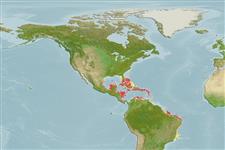>
Gobiiformes (Gobies) >
Gobiidae (Gobies) > Gobiinae
Etymology: Bathygobius: Greek, bathys = deep + Latin, gobius = gudgeon (Ref. 45335); antilliensis: Name formed from the proper noun 'Antilles', in reference to the islands of the Antilles, which constitute most of the known range of this species and where it is most abundant..
Environment: milieu / climate zone / depth range / distribution range
Écologie
marin benthopélagique. Tropical
Western Atlantic: insular and continental islands in the Caribbean.
Taille / Poids / Âge
Maturity: Lm ? range ? - ? cm
Max length : 9.4 cm SL mâle / non sexé; (Ref. 85559)
Description synthétique
Morphologie | Morphométrie
Épines dorsales (Total): 7; Rayons mous dorsaux (Total): 9; Épines anales 1; Rayons mous anaux: 8. This species is distinguished by the following characters: 18-21 pectoral fin rays; 38-42 lateral scale rows; upper jaw length 9.5-13 % SL, rarely less than 11% SL; predorsal squamation reaching anteriorly beyond vertical through posterior margin of preopercle, often reaching posterior edge of postorbital blotch; first dorsal fin with 1-4 dark blotches on each element forming 1-4 stripes across fin or with one broad, dark brown longitudinal stripe across middle of fin; ventral portion of trunk with 2 rows of markings, upper row with 7-8 dark blotches along lateral midline from beneath pectoral fin to point just anterior to markings on caudal peduncle, lower row typically consisting of 3 conspicuous dark spots - occasionally with diffuse 4th spot beginning beneath ventral portion of pectoral fin and terminating just anterior to origin of anal fin (Ref. 85559).
Collected primarily from reef crests and from shallow tidepools on exposed beaches, where it typically co-occurs with B. mystacium and B. lacertus. A single specimen was collected from a sheltered rocky shoreline near an irrigation canal in Puerto Rico and associated with three species, B. geminatus, B. lacertus, and B. soporator. GenBank accession number for COI sequence of holotype: HM748393 (Ref. 85559).
Life cycle and mating behavior
Maturité | Reproduction | Frai | Œufs | Fécondité | Larves
Tornabene, L., C. Baldwin, L.A. Weigt and F. Pezold, 2010. Exploring the diversity of western Atlantic Bathygobius (Teleostei: Gobiidae) with cytochrome c oxidase-I, with descriptions of two new species. aqua, Int. J. Ichthyol. 16(4):141-170. (Ref. 85559)
Statut dans la liste rouge de l'IUCN (Ref. 130435)
Menace pour l'homme
Harmless
Utilisations par l'homme
Plus d'informations
PaysZones FAOÉcosystèmesOccurrencesIntroductionsStocksÉcologieRégime alimentaireÉléments du régime alimentaireConsommation alimentaireRation
Noms communsSynonymesMétabolismePrédateursÉcotoxicologieReproductionMaturitéFraiRassemblement de ponteFéconditéŒufsDéveloppement de l'œuf
Taille/ÂgeCroissanceLongueur-poidsLongueur-longueurFréquences de longueursMorphométrieMorphologieLarvesDynamique des populations larvairesRecrutementAbondanceBRUVS
RéférencesAquacultureProfil d'aquacultureSouchesGénétiqueElectrophoresesHéritabilitéPathologiesTraitementNutrientsMass conversion
CollaborateursImagesStamps, Coins Misc.SonsCiguateraVitesseType de nageSurface branchialeOtolithesCerveauxVision
Outils
Articles particuliers
Télécharger en XML
Sources Internet
Estimates based on models
Preferred temperature (Ref.
123201): 26.7 - 28.2, mean 27.5 °C (based on 541 cells).
Phylogenetic diversity index (Ref.
82804): PD
50 = 0.5000 [Uniqueness, from 0.5 = low to 2.0 = high].
Bayesian length-weight: a=0.00708 (0.00333 - 0.01504), b=3.09 (2.92 - 3.26), in cm total length, based on LWR estimates for this (Sub)family-body shape (Ref.
93245).
Niveau trophique (Ref.
69278): 3.5 ±0.5 se; based on size and trophs of closest relatives
Fishing Vulnerability (Ref.
59153): Low vulnerability (10 of 100).
